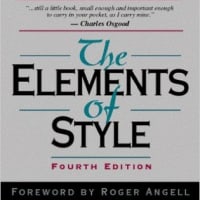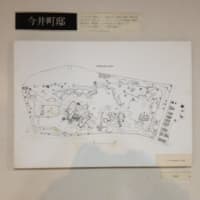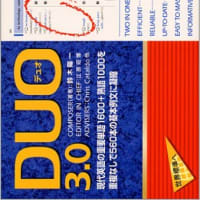英検1級1次に合格するまでmixi上でよく参考にさせていただいたサイトがあります:『英検1級合格栗坂方程式/koolieのブログ』
いかがでしょうか?15分でどれだけ正答できたかな???
栗坂さんのブログによれば、出典が明らかなら典拠してもオッケーなので
以下に貼り付けてみます。
興味のある方、一度tryしてみてください。
■下記の設問3問から構成される、読解内容一致模擬大1問題を15分以内時間厳守で
解いてみてください。15分でできなければ、それがあなたの今の実力ですので
時間を超えて問題は解かない。自分の実力に正直になって解いてみましょう!
∞∞∞∞∞∞∞∞∞∞∞∞∞∞∞∞∞∞∞∞∞∞∞∞∞∞∞∞∞∞∞∞∞∞∞∞
【制限時間15分厳守】読解内容一致模擬問題
The New World of DNA
∞∞∞∞∞∞∞∞∞∞∞∞∞∞∞∞∞∞∞∞∞∞∞∞∞∞∞∞∞∞∞∞∞∞∞∞
When John Keats read George Chapman's translation of Homer he felt,
in his elevated, poetical way, like "some watcher of the skies/When a new
planet swims into his ken". So may many biologists feel a new world when
they get their hands on the first full release of analysis from a project
called ENCODE-a release which includes some 30 research papers, six of them
in the journal Nature, and a huge amount of well-curated data being made
freely available online. This is biology on a scale that takes hundreds of
people years of their lives, costing as much as all but the biggest telescopes
used by today's watchers of the skies.
The revelation's effect may be poetic in its grandeur. Its nature,
though, is prosaic. It is a parts list: ENCODE stands for Encyclopedia of
DNA(Deoxypentose Nucleic Acid) Elements. The consortium that created it-442 members
in 32 institutes around the world-has used the increasingly impressive tools
available for sequencing genomes to mount a systematic analysis of 147 different
types of human cell, attempting to say just what each part of the genome is
doing in them. Their results confirm on a grand scale what has become clear
over the decade since the Human Genome Project first produced a sequence of
the three billion "letters" of which the genome is made: there is a great deal
more to genomes than their genes.
When genes were first given a molecular basis, it was a fairly simple one.
A gene was a piece of DNA that described a protein. When a cell had need of
that protein it would cause a copy of the gene to be transcribed from DNA
into RNA(Ribonucleic Acid), a similar molecule capable of taking on more
diverse forms. That RNA transcript would then be translated to make a protein.
The bits of the genome which describe proteins this way have long been known
to be only a fraction of the whole-a bit more than 1%-though it was accepted
that some of the surrounding DNA was necessary to get the transcription machinery
on and off the genes, thus turning them on or off as required. Human genes
proved to be longer than might have been expected, with the RNA transcripts
edited and rearranged before being translated into protein. Still, it seemed
as if only a small fraction of the genome was actually doing anything,
while that a lot of the rest was, or might as well be,"junk".
Now ENCODE has shown that fully three-quarters of the genome is transcribed
into RNA at some stage in at least one of the body’s different types of cell.
Some transcripts are whittled down more or less immediately, but 62% of the genome
can end up in the form of a transcript that looks stable. There is a sense
in which these transcripts are the basic constituents of the genome-its atoms,
if you like. The transcripts which are associated with genes describing proteins
are just one type among many.
All this RNA has a wide variety of uses. It regulates what genes actually
make protein and how much is made in all sorts of complicated ways; some transcripts
are millions of times more common than others. Even ENCODE has not been able to
catalogue all of this diversity, but it has made headway in clarifying what to look for.
Hence a new interest in finding ways to look at what is going on in
single cells, not least because that will be the way that models of how
the switching systems work can most easily and thoroughly be tested.
That is the thrilling frontier for labs like those that worked on ENCODE.
In a decade that frontier could go as far beyond ENCODE as ENCODE has
surpassed the original genome-sequencing efforts.
------------------------------------------------------------------------
Question: Read the passage and chose the best answer from among the
four choices for each question. Then, circle the number of the question
by a ball-point pen or pencil.
------------------------------------------------------------------------
(1) Why may John Keats and many biologists alike feel a new world
even though they work on a different field?
1. Both revelation's chain reaction is supposed to be poetical way
with grandeur, although those nature are prosaic.
2. The method to sequence human genomes and to find a new planet have
the same spirit to lead a better place on world, no matter how long
it takes a time.
3. Sequencing genome has happened to become common target of the research
on both astronomy's and human gene's researchers.
4. Relentless time consuming, efforts, and costs have brought out them
a splendid and grand scale newly findings on each specialized field.
(2) Which of the following best describes the topic of the passage?
1. While the fundamental character itself is plain, a long-term effort
to catalogue all the bits of the human genome that do something
has released its upshots.
2. The new world of DNA has finally envisioned of regenerating human's
cell such as a lung and a hand, since ENCODE, a release which
includes some 30 research papers, six of them in the journal Nature
has established.
3. Some of the surrounding DNA of human genes play a inevitable role in
actually doing anything with a bit more than 1% when a gene is [
a piece of DNA consisted of protein.
4. The consortium has argued that completely three-quarters of the genome
is written in full into RNA to emulate the emergence of
human gene-sequencing efforts thanks to a parts list, ENCODE.
(3) What is the thrilling frontier aiming at?
1. Not only producing a sequence of the three billion "letters" of
which the genome is made, but finding out the rest of them,
even though those are considered as junk.
2. Finding out varieties of human genome on their DNA and RNA about whether
single cells have something to do with them or not.
3. An improved parts list of ENCODE with far prevailing the original
genome-sequencing efforts.
4. The RNA transcript of a small fraction of the human genome as well as
primate's one to advance the medical treatment on Alzheimer's disease.
私もやってみました!
なんとかギリギリ3問とも正解でした(ため息)。
いや~、1級の内容一致問題、恐るべし。
というのも、1次通過の10月末から2次攻略のために
じっくりと英文を精読することをやめていたからだと思う。
これは癖づけ、つまり習慣づけの問題だなぁ、と実感。
ただ、私は視覚重視で語学を学ぶタイプなので
こういう一見面倒くさい読解問題はかなり好きだな。
とは言っても、私の「あともうちょっとでまだまだ」という点は、
なぜこの答えなの?というのが、明解に指摘できないレベル。
ここが、「だからこうなるんさ~♪」まで行けば
1級1次の大問2-3は満点取れるでしょう。
そういう受験生は、リスニングも相乗効果が上がって
34点満点で25点以上はいつも安定して得点できると思う。
あっ、そういえば解答がまだでしたね!
∞∞∞∞∞∞∞∞∞∞∞∞∞∞∞∞∞∞∞∞∞∞∞∞∞∞∞∞∞∞∞∞∞∞∞∞
解答
∞∞∞∞∞∞∞∞∞∞∞∞∞∞∞∞∞∞∞∞∞∞∞∞∞∞∞∞∞∞∞∞∞∞∞∞
(1) 正解4. 正解ヒントは第1パラ第1~第3センテンスの言い換えが選択肢4.
(2) 正解1. 結論センテンスは第2パラ第5(最後)センテンスが選択肢1.
(3) 正解 3. 正解ヒントは第6パラ最後センテンスの言い換えが選択肢3.
すっかり上級者気分だと思いきや、いやいや、読解力もあっという間に消えてしまいます。
やっと以前のように週刊誌TIMEの精読(濫読?)に戻れそうな気分。
自分の不備を認めつつ、もっと高みを目指す努力をしたいと思いますね。
いかがでしょうか?15分でどれだけ正答できたかな???
栗坂さんのブログによれば、出典が明らかなら典拠してもオッケーなので
以下に貼り付けてみます。
興味のある方、一度tryしてみてください。
■下記の設問3問から構成される、読解内容一致模擬大1問題を15分以内時間厳守で
解いてみてください。15分でできなければ、それがあなたの今の実力ですので
時間を超えて問題は解かない。自分の実力に正直になって解いてみましょう!
∞∞∞∞∞∞∞∞∞∞∞∞∞∞∞∞∞∞∞∞∞∞∞∞∞∞∞∞∞∞∞∞∞∞∞∞
【制限時間15分厳守】読解内容一致模擬問題
The New World of DNA
∞∞∞∞∞∞∞∞∞∞∞∞∞∞∞∞∞∞∞∞∞∞∞∞∞∞∞∞∞∞∞∞∞∞∞∞
When John Keats read George Chapman's translation of Homer he felt,
in his elevated, poetical way, like "some watcher of the skies/When a new
planet swims into his ken". So may many biologists feel a new world when
they get their hands on the first full release of analysis from a project
called ENCODE-a release which includes some 30 research papers, six of them
in the journal Nature, and a huge amount of well-curated data being made
freely available online. This is biology on a scale that takes hundreds of
people years of their lives, costing as much as all but the biggest telescopes
used by today's watchers of the skies.
The revelation's effect may be poetic in its grandeur. Its nature,
though, is prosaic. It is a parts list: ENCODE stands for Encyclopedia of
DNA(Deoxypentose Nucleic Acid) Elements. The consortium that created it-442 members
in 32 institutes around the world-has used the increasingly impressive tools
available for sequencing genomes to mount a systematic analysis of 147 different
types of human cell, attempting to say just what each part of the genome is
doing in them. Their results confirm on a grand scale what has become clear
over the decade since the Human Genome Project first produced a sequence of
the three billion "letters" of which the genome is made: there is a great deal
more to genomes than their genes.
When genes were first given a molecular basis, it was a fairly simple one.
A gene was a piece of DNA that described a protein. When a cell had need of
that protein it would cause a copy of the gene to be transcribed from DNA
into RNA(Ribonucleic Acid), a similar molecule capable of taking on more
diverse forms. That RNA transcript would then be translated to make a protein.
The bits of the genome which describe proteins this way have long been known
to be only a fraction of the whole-a bit more than 1%-though it was accepted
that some of the surrounding DNA was necessary to get the transcription machinery
on and off the genes, thus turning them on or off as required. Human genes
proved to be longer than might have been expected, with the RNA transcripts
edited and rearranged before being translated into protein. Still, it seemed
as if only a small fraction of the genome was actually doing anything,
while that a lot of the rest was, or might as well be,"junk".
Now ENCODE has shown that fully three-quarters of the genome is transcribed
into RNA at some stage in at least one of the body’s different types of cell.
Some transcripts are whittled down more or less immediately, but 62% of the genome
can end up in the form of a transcript that looks stable. There is a sense
in which these transcripts are the basic constituents of the genome-its atoms,
if you like. The transcripts which are associated with genes describing proteins
are just one type among many.
All this RNA has a wide variety of uses. It regulates what genes actually
make protein and how much is made in all sorts of complicated ways; some transcripts
are millions of times more common than others. Even ENCODE has not been able to
catalogue all of this diversity, but it has made headway in clarifying what to look for.
Hence a new interest in finding ways to look at what is going on in
single cells, not least because that will be the way that models of how
the switching systems work can most easily and thoroughly be tested.
That is the thrilling frontier for labs like those that worked on ENCODE.
In a decade that frontier could go as far beyond ENCODE as ENCODE has
surpassed the original genome-sequencing efforts.
------------------------------------------------------------------------
Question: Read the passage and chose the best answer from among the
four choices for each question. Then, circle the number of the question
by a ball-point pen or pencil.
------------------------------------------------------------------------
(1) Why may John Keats and many biologists alike feel a new world
even though they work on a different field?
1. Both revelation's chain reaction is supposed to be poetical way
with grandeur, although those nature are prosaic.
2. The method to sequence human genomes and to find a new planet have
the same spirit to lead a better place on world, no matter how long
it takes a time.
3. Sequencing genome has happened to become common target of the research
on both astronomy's and human gene's researchers.
4. Relentless time consuming, efforts, and costs have brought out them
a splendid and grand scale newly findings on each specialized field.
(2) Which of the following best describes the topic of the passage?
1. While the fundamental character itself is plain, a long-term effort
to catalogue all the bits of the human genome that do something
has released its upshots.
2. The new world of DNA has finally envisioned of regenerating human's
cell such as a lung and a hand, since ENCODE, a release which
includes some 30 research papers, six of them in the journal Nature
has established.
3. Some of the surrounding DNA of human genes play a inevitable role in
actually doing anything with a bit more than 1% when a gene is [
a piece of DNA consisted of protein.
4. The consortium has argued that completely three-quarters of the genome
is written in full into RNA to emulate the emergence of
human gene-sequencing efforts thanks to a parts list, ENCODE.
(3) What is the thrilling frontier aiming at?
1. Not only producing a sequence of the three billion "letters" of
which the genome is made, but finding out the rest of them,
even though those are considered as junk.
2. Finding out varieties of human genome on their DNA and RNA about whether
single cells have something to do with them or not.
3. An improved parts list of ENCODE with far prevailing the original
genome-sequencing efforts.
4. The RNA transcript of a small fraction of the human genome as well as
primate's one to advance the medical treatment on Alzheimer's disease.
私もやってみました!
なんとかギリギリ3問とも正解でした(ため息)。
いや~、1級の内容一致問題、恐るべし。
というのも、1次通過の10月末から2次攻略のために
じっくりと英文を精読することをやめていたからだと思う。
これは癖づけ、つまり習慣づけの問題だなぁ、と実感。
ただ、私は視覚重視で語学を学ぶタイプなので
こういう一見面倒くさい読解問題はかなり好きだな。
とは言っても、私の「あともうちょっとでまだまだ」という点は、
なぜこの答えなの?というのが、明解に指摘できないレベル。
ここが、「だからこうなるんさ~♪」まで行けば
1級1次の大問2-3は満点取れるでしょう。
そういう受験生は、リスニングも相乗効果が上がって
34点満点で25点以上はいつも安定して得点できると思う。
あっ、そういえば解答がまだでしたね!
∞∞∞∞∞∞∞∞∞∞∞∞∞∞∞∞∞∞∞∞∞∞∞∞∞∞∞∞∞∞∞∞∞∞∞∞
解答
∞∞∞∞∞∞∞∞∞∞∞∞∞∞∞∞∞∞∞∞∞∞∞∞∞∞∞∞∞∞∞∞∞∞∞∞
(1) 正解4. 正解ヒントは第1パラ第1~第3センテンスの言い換えが選択肢4.
(2) 正解1. 結論センテンスは第2パラ第5(最後)センテンスが選択肢1.
(3) 正解 3. 正解ヒントは第6パラ最後センテンスの言い換えが選択肢3.
すっかり上級者気分だと思いきや、いやいや、読解力もあっという間に消えてしまいます。
やっと以前のように週刊誌TIMEの精読(濫読?)に戻れそうな気分。
自分の不備を認めつつ、もっと高みを目指す努力をしたいと思いますね。




















仕事に必要ないので(爆)
この栗坂さんっていう人のサイトしってる~。
この人。。。怪しい人ではないんですか(爆)
サイトで延々、語って最後に、なんか「買わせる」サイトってあるからつい、うたぐってしまいますわ。
明日、英会話カフェにいってきます!!(敬礼)
私、どこか、または、誰かに心酔して
どっぷりその~イズムっぽく信奉者として学ぶことが
さっぱりできない輩です。
それには理由があって、多数派というのがいつも正しいとは限らないから。
ちょっと堅い言い方すると、全体主義っぽいカリスマ性がある人物は
すごく警戒して、自分がそこへ入るのは止めるようにしてます。
というのも、自分が「無」になるしかなくて
全く良いところがなくなってしまいそうになるから、です。
なので、植田イッチーさんとか、この栗坂さんとか、
エッセンスはいただきますけど、参考にさせていただくのみ、です。
薬の効き目と同じで、自分に効くかどうか
これは誰にもわかんないしねぇ。
でも、1級レベルへ受験生を導けるって豪語してる人物が、
どういう方法でそれを言い切れるのか、
そこに興味があるんですよね。
やっぱ「哲学」かなぁ??
お人形さん遊びはせずに、全部お洋服を脱がして
人形がどうなってるか調べずにいられなかった
ヤバい性格が三つ子の魂なんとかでまだ抜けきれずにあります(汗)。